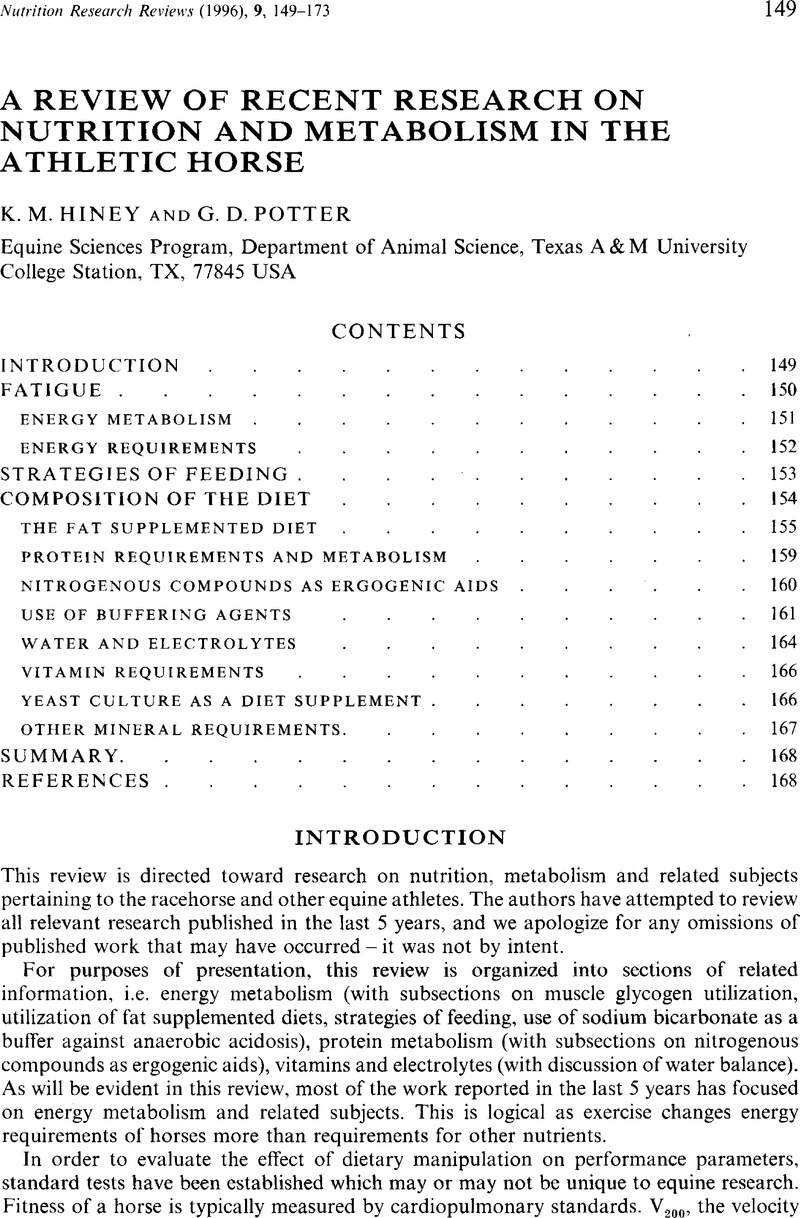Crossref Citations
This article has been cited by the following publications. This list is generated based on data provided by Crossref.
LINDBERG, J. E.
and
KARLSSON, C. PALMGREN
2001.
Effect of partial replacement of oats with sugar beet pulp and maize oil on nutrient utilisation in horses.
Equine Veterinary Journal,
Vol. 33,
Issue. 6,
p.
585.
TROTTIER, N. L.
NIELSEN, B. D.
LANG, K. J.
KU, P. K.
and
SCHOTT, H. C.
2002.
Equine endurance exercise alters serum branched‐chain amino acid and alanine concentrations.
Equine Veterinary Journal,
Vol. 34,
Issue. S34,
p.
168.
Lacombe, Véronique A.
Hinchcliff, Kenneth W.
and
Taylor, Lynn E.
2003.
Interactions of substrate availability, exercise performance, and nutrition with muscle glycogen metabolism in horses.
Journal of the American Veterinary Medical Association,
Vol. 223,
Issue. 11,
p.
1576.
2004.
Equine Nutrition and Feeding.
p.
568.
Galvão, Patrícia Maia
Almeida, Fernando Queiroz de
Oliveira, Chiara Albano de Araújo
Lima, José Roberto Pinto de Andrade
Vieira, Antônio Assis
Adese, Bruna
and
Santos, Tiago Marques dos
2004.
Avaliação de dietas para eqüinos de uso militar em atividade física moderada.
Revista Brasileira de Zootecnia,
Vol. 33,
Issue. 6,
p.
1492.
Mattos, Fernando
Araújo, Kleber Villela
Leite, Gilberto Gonçalves
and
Goulart, Herbert de Moura
2006.
Uso de óleo na dieta de eqüinos submetidos ao exercício.
Revista Brasileira de Zootecnia,
Vol. 35,
Issue. 4,
p.
1373.
LACOMBE, V. A.
HINCHCLIFF, K. W.
KOHN, C. W.
REED, S. M.
and
TAYLOR, L. E.
2006.
Effects of dietary glycaemic response after exercise on blood concentrations of substrates used indirectly for muscle glycogenesis.
Equine Veterinary Journal,
Vol. 38,
Issue. S36,
p.
585.
Brandi, Roberta Ariboni
Furtado, Carlos Eduardo
Martins, Elias Nunes
Freitas, Eduardo Villela Villaça
Queiroz-Neto, Antônio de
and
Lacerda-Neto, José Corrêa de
2010.
Parâmetros bioquímicos de equinos submetidos à simulação de prova de enduro recebendo dietas com adição de óleo de soja.
Revista Brasileira de Zootecnia,
Vol. 39,
Issue. 2,
p.
313.
Oliveira, R.N.
Marques Jr, A.P.
Xavier, P.R.
Alves, G.E.S.
Paes, P.R.O.
and
Gobesso, A.A.O.
2010.
Avaliação hematológica e bioquímica de equinos suplementados com óleo de arroz semirrefinado, rico em gamaorizanol.
Arquivo Brasileiro de Medicina Veterinária e Zootecnia,
Vol. 62,
Issue. 5,
p.
1043.
Sales, J.
and
Homolka, P.
2011.
A meta-analysis of the effects of supplemental dietary fat on protein and fibre digestibility in the horse.
Livestock Science,
Vol. 136,
Issue. 2-3,
p.
55.
Brunner, J.
Wichert, B.
Burger, D.
von Peinen, K.
and
Liesegang, A.
2012.
A survey on the feeding of eventing horses during competition.
Journal of Animal Physiology and Animal Nutrition,
Vol. 96,
Issue. 5,
p.
878.
Garcia, Helio Alberto Cumani
Furtado, Carlos Eduardo
Brandi, Roberta Ariboni
Soncin, Mara Regina Schimmack Pedro
Balieiro, Júlio Cesar de Carvalho
and
Souza, Aline Duarte de
2013.
Blood parameters and apparent digestibility of concentrate with rice oil for horses.
Ciência e Agrotecnologia,
Vol. 37,
Issue. 5,
p.
435.
Menezes, Madalena Lima
Brandi, Roberta Ariboni
Bueno, Ives Cláudio da Silva
Balieiro, Júlio Cesar de Carvalho
Moreira, Camilla Garcia
and
Nascimento, Olivia Carmen de Araújo
2014.
Effects of diets with increasing levels of citrus pulp on the blood parameters linked to energy metabolism in horses.
Ciência e Agrotecnologia,
Vol. 38,
Issue. 6,
p.
589.
Laghi, Luca
Zhu, Chenglin
Campagna, Giuseppe
Rossi, Giacomo
Bazzano, Marilena
and
Laus, Fulvio
2018.
Probiotic supplementation in trained trotter horses: effect on blood clinical pathology data and urine metabolomic assessed in field.
Journal of Applied Physiology,
Vol. 125,
Issue. 2,
p.
654.
Graham-Thiers, Patty M
and
Bowen, LaAnn K
2021.
The effect of time of feeding on plasma amino acids during exercise and recovery in horses.
Translational Animal Science,
Vol. 5,
Issue. 2,
Graham-Thiers, Patty M
and
Bowen, L Kristen
2024.
Effect of balanced vs. standard protein on muscle mass development in exercising horses.
Translational Animal Science,
Vol. 8,
Issue. ,



